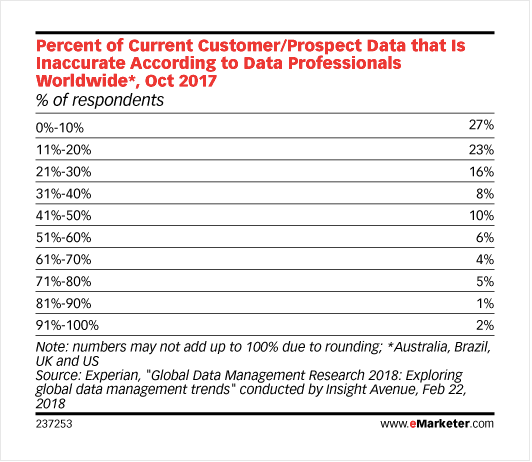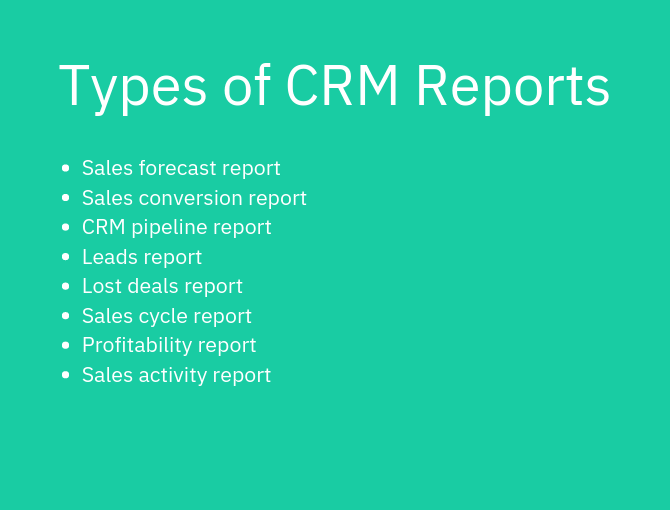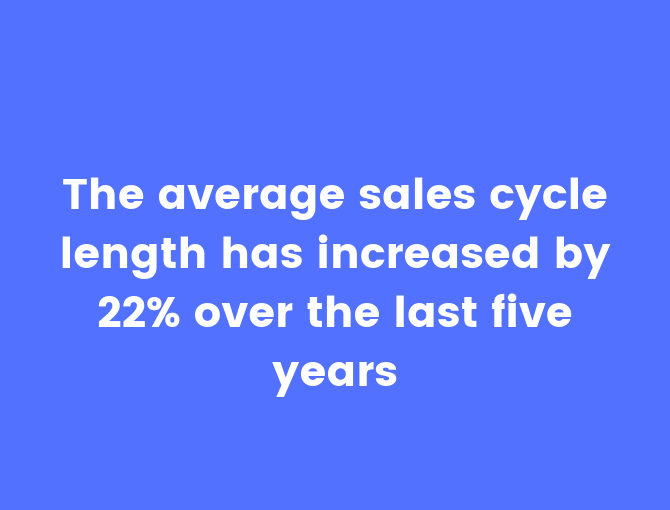Here are 7 types of CRM reports:
- CRM pipeline report
- Profitability report
- Sales cycle report
- Sales performance report
- Sales forecast report
- Sales conversion report
- Goal progress report
A CRM report goes by many names, and there are a variety of report types you can use for your business. Just one thing…
Do you know how to make a CRM report?
By the end of this post, you will. And it only takes 3 steps.
CRM reports are made to help you…
- Sell smarter
- Track the progress of your goals
- Quickly pinpoint problems
Reports can also help you track campaign performance and measure ROI — which is harder than you think.
This post will show you how to make a CRM report in only 3 steps.
How can CRM reporting help your business?
CRM reporting can help your business because it lets you:
- Track deal flow and the performance of sales reps
- Find data gaps that can affect the business results
- Understand your ideal customer profile, and which leads are more likely to convert
Overall, CRM reporting helps you uncover what is actually happening in your business.
Too often, you might think that leads are going to the right sales reps, or that your reps are calling and working the leads until they become customers…
…but then CRM reporting shows you that your sales reps aren’t reaching out, or lead flow isn’t reaching the right reps. And you aren’t getting the sales you thought you were.
Don’t let that happen to you. Build a CRM report.
How to make a CRM report in 3 steps
First off, you’ll have to decide what type of report you want to make: canned or custom
Canned reports are pre-made reports that you don’t need to set up or spend time tweaking. The time-saving is useful, but these reports are sometimes limited to generic, industry-standard analytics (like sales forecasts and revenue). They may not give you all the info you need.
For more nuanced reporting, you can use custom reports. Custom reports are useful when you have a specific question you need to answer for your business – and industry-standard reports just can’t get the job done.
Here are the 3 steps to effective CRM reports:
- Weed out inaccurate customer info with an audit
- Choose the types of CRM reports you need
- Choose CRM metrics to measure
Step 1: Weed out inaccurate customer info with an audit
Even smaller business owners hold onto a lot of customer info. So the idea of going through all of it probably sounds like a pain.
This might be true. But an info audit is well worth your time – because inaccurate customer info will hurt your business.
Did you know that…
- Sales departments annually lose approximately 550 hours and $32,000 per rep because of bad prospect data? And that 40% of email users change their email address at least once every two years?

Experian did a study of 1,000 employees worldwide who can see how their employer manages data. That study found that on average about 30% of their customer firms’ data is inaccurate.
What’s the biggest reason cited for this much inaccurate customer info?
Plain old human error – followed closely by a lack of internal communication between company departments, according to 36% of the study participants.
Yes, there’s no perfect fix to human error. But you can buckle down on your data and take steps to avoid as many errors as possible.
Yes, this might take some time, but it’s not quite Mount Everest. First, just make sure you…
Talk to everyone who has customer info access
Whether your business is 5 people or 50 people, you need to know a few things about access to your customer’s personal info.

Your current info collection and update process: What’s the schedule for monitoring info collection and for doing info updates? Before you can change your customer info care processes, you need a complete understanding of what they are.
The sources of your customer info: A lot of customer info quality problems happen as info gets added to your system. This can happen because of…
- Incorrect tagging or custom field errors
- Automations that change the wrong things
- Forms that double submit
Who handles your customer info: Limiting access to a smaller amount of people makes it easier to control what happens to your data. But your business size and needs may not let you keep the access count to a minimum.
If multiple people across your company need to access customer data, make sure to:
- They get trained in your security processes
- They know how to create secure passwords
- You have a point person available to supervise their access
- Understand how to handle phishing attempts via email or phone calls
Did you know that 76% of businesses reported being a victim of a phishing attack in the last year?

Think about the less obvious risks to your customer’s personal info.
It only takes one misstep to jeopardize your customer’s info – and your reputation as a business. Make sure everyone with data access knows what they’re doing.
Learn what info you have (and where all of it is)
A CRM is great for keeping all customer info organized, but that doesn’t mean there aren’t other pieces of info floating outside of it. Gather it all in one place.
What were you previously using to organize your customer info? Lots of companies use things like Excel or Google Sheets, or even a classic – hard copies in file cabinets.
Another hidden spot? Your email inbox. Make sure there aren’t stray bits of info in your email archives.
The last place you should check?
Trick question – it’s actually places. Because there’s probably customer info in every app you use (and integrate your CRM with). Apps like your…
- Payment processor
- Forms tool
- Project management tool
- Support tool
All of these integrations keep customer info – like credit card numbers, email addresses, payment history, support tickets, and every interaction they’ve had with your business.
Assign a value to all of your existing customer info
What information is worth keeping? What information affects how you do business?
Take a look back into everything you did in the past year and what info you used to target and sell to people. This can help you predict what info will make the most meaningful impact going forward.
The question to ask: “Does this info affect how I should talk to this person?“
The actions your customers show will tell you what info to keep.
- If they’ve bought from you before, that purchase history affects what you offer them next
- If they fill out a specific form on your website, that’s information you know is relevant
- If they’ve opened certain types of emails over others, you can use that to segment your communication with them
- If they’ve mentioned problems they want to solve, you can use that information to target emails, content, and products that will help
Did you use geographic location info to target someone who wound up buying? Hang onto that info. A note from a past check-in call talking about the weather in that location? Probably not important for your conversion rate.
Make sure what’s left is accurate
Remember that human error problem? Even when your goal is to organize your customer info, errors can still happen in the auditing process. And none of that info will do you any good in reports if it isn’t accurate.
A CRM is smart and helpful, but only you can provide the data actually going into it. As we all learned in grade school, double-check your work.
The Winterberry Group surveyed North American marketers and tech developers. Approximately half of them said that centralizing ownership of customer info would be one of the most important changes that their organization could make to get value from customer info.
A CRM can help with that.
Step 2: Choose the types of CRM reports you need
Your data is clean and accurate, and you will keep collecting more. Now you need reports to tell you what it means.
How many times have you heard the phrase “make data-driven decisions?”
Probably a lot. And although it’s a tad overused, it’s valid. Data helps you make smarter decisions for your business, and analytics reports are how you get it.
CRM report categories are organized into three buckets:
- Sales reporting
- Campaign reporting
- Customer reporting
You can use whatever reports you need within these buckets, but here are 8 types of CRM reporting you’ll come across in your CRM platform.

All the info you need to be successful is in a CRM.
Sales forecast report: No one can predict the future, but you can make educated guesses! Using lead data and sales trends, a sales forecast report helps you project future revenue based on the deals you have right now.
ActiveCampaign offers this with our Win Probability CRM feature – you can see a percentage measurement that forecasts the probability of winning or losing a deal based on an individual deal basis.
Sales conversion report: Sales conversion reports tell you what percentage of leads convert into won deals within a specified date range.
This report is typically broken down by the lead source, and can show you information like:
- 17% of email leads converted last month, compared to only 3% of paid ads
- Leads from referral sources convert 30% faster than leads from other sources
- Organic leads account for 60% of leads but have a 15% lower deal size on average
CRM pipeline report: CRM pipeline reports shows the progress of your leads through the decision process. It also shows any pending opportunities that are about to enter the pipeline. This helps salespeople prioritize deals and take the next steps as needed.
Leads report: Where are your leads coming from? This report organizes that data. You can use it to decide which channels might need more attention or adjusting.
Lost deals report: You win some, you lose some. It happens, but when it does, there’s a report for you to see which deals were lost and the reasons why. This intel will help you adjust processes as you advance other deals in the pipeline.

Sales cycle report: A lot of little things can affect how long a deal takes from start to finish. Did you know that the average sales cycle has increased by 22% over the last five years? It helps to know how to plan. This report tells you the average full cycle duration across different lead sources.
Profitability report: A profitability report shows you specifically which customers are bringing in the money. Based on a deal’s history with you (such as purchase history), that info can tell you which customers are most loyal, which contribute most to your revenue, and which will keep buying from you.
Sales activity report: An activity report tracks activities (like calls and appointments) done in the previous week, plus activities scheduled for the upcoming week. This helps sales reps manage their time.
In the ActiveCampaign Deals CRM, this is called a Deal Owner report. You can view the performance of your sales team over time. It shows all deals Created, marked as Won, and marked as Lost by you and your Deal Owners.
Step 3: Choose CRM metrics to measure
“What gets measured gets managed”
This is a famous quote from Peter Drucker, and speaks to the importance of measuring things – stuff gets done when you have a number that holds people accountable.
Whether you use a CRM for new lead management or to keep track of existing customers, you need metrics. You aren’t pulling all of those reports for fun, so you need to decide what metrics are most important for you to measure.
Prepare yourself – a list dump of sales, marketing, and support CRM metrics is about to appear. Stay calm, it will only take a minute and you don’t have to read the whole thing.
Ready? Note: Don’t use them all.
- Number of prospects
- Number of new customers
- Number of retained customers
- Close rate
- Renewal rate
- Number of sales calls made
- Number of sales calls per opportunity
- Amount of new revenue
- Number of open opportunities
- Sales stage duration
- Sales cycle duration
- Number of proposals given
- Number of campaigns
- Number of campaign responses
- Number of campaign purchases
- Revenue generated by a campaign
- Number of new customers acquired by campaign
- Number of customer referrals
- Number of web page views
- User goal completion rate on the web
- Time per website visit
- Customer lifetime value
- Cross-sell ratio
- Up-sell ratio
- Email list growth rate
- Number of cases handled
- Number of cases closed the same day
- Average time to resolution
- The average number of service calls per day
- Complaint time to resolution
- Number of customer callbacks
- Average service cost per service interaction
- Percentage compliance with SLAs
- Calls lost before being answered
- Average call handling time
Bill Band – an author, noted CRM thought leader, and a former VP and principal analyst at Forrester Research – classifies all of these different metrics into three buckets:
- Business performance metrics
- User adoption metrics
- Customer perception metrics
Here’s how Bill Band recommends you choose the metrics that will help your business.

“When you look at ongoing operational metrics, we see a lot of them in companies, but the question is whether they are tied to an overall strategy. Often that is a missing linkage. In the call center, you might have lots of operational metrics, or in marketing, there are traditional marketing, like campaign management and close rates and so on, but I see a lack of tying metrics to a strategy.” – Bill Band, author, noted CRM thought leader, and former VP and principal analyst at Forrester Research.
Define and quantify business goals
Decide what your CRM goals are and match the necessary metrics accordingly. Ask yourself:
“What sales, marketing, and service outcomes will make the most positive impact on my business?”
Imagine that one of your goals is to budget time and money better for ongoing business expenses. If you want to lower the cost of acquiring and managing customers to help achieve that goal, look at metrics like:
- The number of new customers – What is the cost of each new customer?
- The number of retained customers – This will help tell you what the cost difference between getting new customers and retaining current ones, and where you need to put more resources.
- The sales cycle duration – This will answer things like “How much time is currently being budgeted per customer? Do you need more? Less?”
These metrics will help you learn how much time and money you need for your existing expenses as well as forecast what more you will need to keep scaling.
Create CRM processes and tactics
Define what processes and tactics you need to achieve your goals.
How are you going to set up customer communication that aligns with your goals? Let’s say you are creating a basic pipeline for nurturing new qualified leads. Here’s an idea of what that could look like.

An ActiveCampaign CRM pipeline showing a customer communication process.
Throwing customer info into a CRM and expecting that to be enough to reach your goals isn’t going to work. You have to set some parameters and do a bit of organizing yourself.
Establish appropriate CRM measures with your goals
You will need different metrics for goals across sales, marketing, and customer support.
What if you wanted to reduce the length of your sales cycle timeline? Some sales metrics you should look at would be:
- Sales cycle duration: What does your current sales cycle look like, and what specific parts are taking up time?
- Number of sales calls per opportunity: Are there any unnecessary calls being made that are slowing down the process?
- Number of new customers: How many new customers are you getting per quarter with your current sales cycle?
Say that you wanted to grow your email list more. A couple of marketing metrics to account for could be:
- Number of campaigns: Are you sending too many or too few?
- Number of new customers acquired by campaign: How many emails do you get from different campaigns? Which ones are performing better or worse than others (and how can you improve that)?
- Email list growth rate: how much has your list grown in the last X amount of days? How does that relate to the number of campaigns you’ve sent (and which ones they are)?
Imagine you wanted to establish a better customer follow-up process. Customer service metrics to monitor might include:
- The number of calls handled per agent per day: you can learn what bandwidth each agent has to respond
- The number of cases closed the same day: learn the average lifespan of your current follow-up process and find the gaps in service.
- The number of customer callbacks: how many follow-ups have been necessary in the past?
Monitor these metrics on a regular basis and take remedial action if you find yourself falling short.



